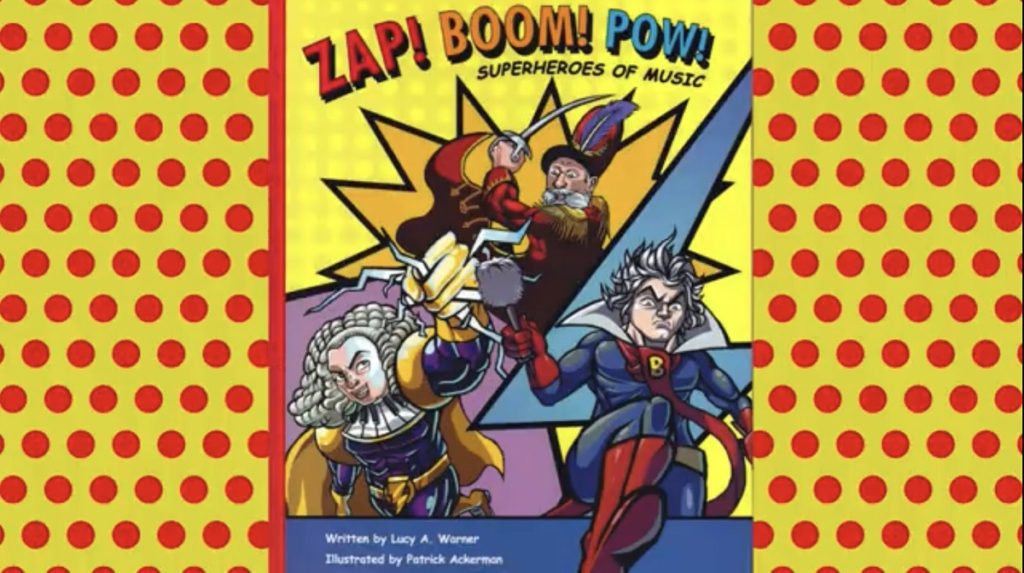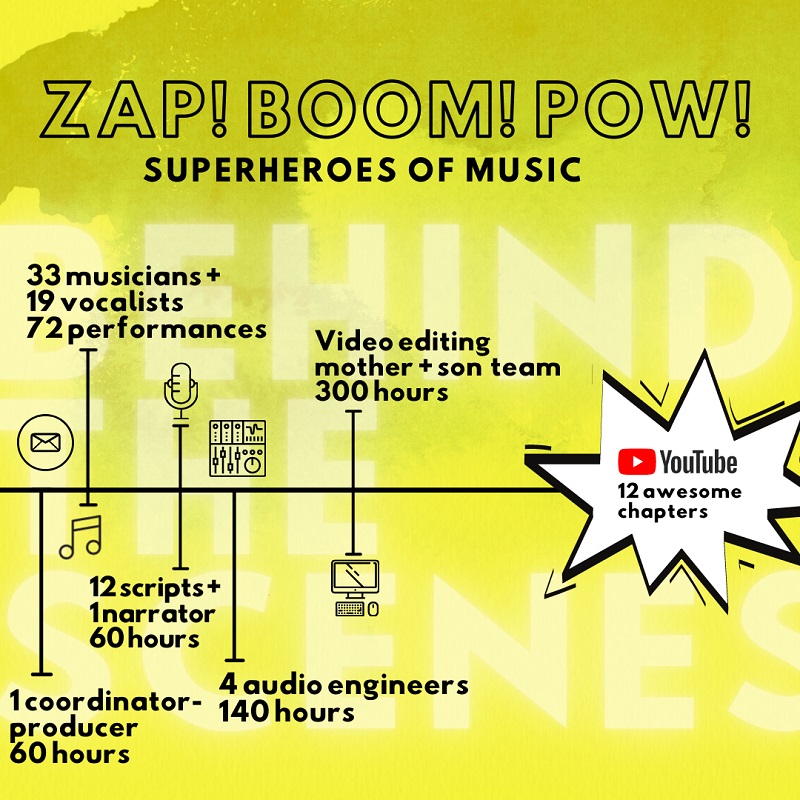One evening in March at the beginning of the Stay At Home order, I was sitting in my living room drinking rosé and organizing my son’s books. As a 5 year old with older cousins to offer hand-me-downs, generous grandparents, and a mom with an amazon habit, he is fortunate enough to have a growing library at home. With Stay At Home in full effect, “Mom-as-Teacher” emerged, and I realized this little library was going to get a lot of action! So I got to putting stuff into piles and came across a gem – “Zap! Boom! Pow! Superheroes of Music,” by Lucy Warner. Given to me years before by SDSO Director of Education Maria Araujo, I had read this book many times to my son. Jack loves all things superheroes and ninjas, so he often requests this book as part of bedtime reading. In the book, Lucy portrays twelve famous classical composers as superheroes, each complete with a superpower. It’s a charming concept, really capturing my son’s imagination with its bright illustrations and whimsical text. When I picked it up that day in March, a thought sprang into my head: “What if I could make these stories into social media videos and accompany them with SDSO performances!”
So was born a project that consumed hundreds of hours by dozens of San Diego Symphony Orchestra musicians and staff in the months since. First, I had to be able to do all this legally. I contacted the author who turned out to be in charge of her own publishing company and the fastest email replier ever. She granted us rights to use her work for these social media videos as long as we didn’t monetize them. Totally easy, since classical music rarely manages to monetize anything. Next, I needed to find a partner in crime- someone who would work tirelessly as a volunteer, with a huge skill set of video editing, who would love brainstorming with me. Enter Susan Wulff and her talented and very funny teenage son Cameron. Together, they are a dream team – so dedicated, so gifted, and so creative. I’m not super sure Susan would have embraced this project with open arms had she realized the scope of the work involved, but fortunately for me she didn’t think that far ahead.
Off to the races we went with planning how to record the musical components while in isolation (an orchestral musician’s worst nightmare!). Music needed to be chosen, arranged, bowings and markings made, parts dispensed, personnel organized and reorganized; Essentially, all the things our wonderful orchestra staff usually seamlessly takes care of now fell on the shoulders of musicians, which was an exciting proposition given that the technology also needed sorting out. Our first attempt using an app-based recording didn’t meet our high artistic standards, so we went back to the drawing board. Seven musicians who had already each sunk a dozen or more hours into the project were asked to re-record, this time with the help of even more musicians now acting as audio engineers to facilitate patched recordings. Through trial and error, a long and growing list of tips and instructions was developed. Hundreds of emails were exchanged. Flow charts to organize the project and “staff” were compiled. Zoom meetings were had, and more meetings, and more meetings. We learned how to build clicks, make midi tracks, and mix tracks together to more closely reflect what we actually produce live as musicians. Sue developed a calendar so everyone knew what to do when. Basically a production company was formed in a few weeks, without any budget or paid personnel mostly due to the relentless drive of Sue.
After we proved we could make a usable recording, we were ready for a narrator to bring Lucy Warner’s text to life. The chapters re-imagine each composer as a superhero – but a very special person would need to read the text and sell it on-screen. I thought back to Reading Rainbow – a classic kids show with a narrator with his own charming personality – and Nuvi Mehta, a professional actor/violinist/conductor and Voice of the San Diego Symphony seemed the only possible choice. Nuvi got a feverish email from me: we needed him to be our narrator, and we needed him now. Once again I talked someone into something that, had they known the scope of work involved, they maybe would have declined. And yet Nuvi said yes! My little electric car then became a delivery vehicle, and I became a showrunner. (Not that I run the show, I just run stuff around for the show.) Susan owned professional quality lighting, which the little electric car delivered. Oops, Susan owned a green screen, which Nuvi might need. Back and forth until Nuvi had all the clorox-wiped equipment required. Next, Nuvi spent hours on Facetime with Sue perfecting his setup, experimenting with his microphone, lights, camera placement. We had to figure out file transfers and audio quality. So so many details that, once again, would normally be handled by management.
The book’s first chapter, Vivaldi, was finally going into production. After having time to practice, Nuvi made his narration recording, the artists had recorded, and the mixing was done. Sounds like we’re closing in on a finished product, right? No. Now Sue and Cam really started the work. Conservatively, I estimate it took them 30-40 hours to make the first 3 minute Vivaldi chapter. Patrick Ackerman, the illustrator for the book, drew these energetic renderings of the composers but each single chapter only contained a single illustration. Much more was needed to put the story onscreen. Many animations were assembled from scratch by Sue and Cam. I learned the ins and outs of file types and file sharing, digging through the internet working to source the dozen or more public domain and creative commons copyrighted images needed as B roll to bring the composer to life onscreen.
We spent all of April and May assembling the first four chapters of the book to be ready to launch on Facebook and Instagram. Many edits were made, files sent and approved, videos compressed (again, Sue) and uploaded. Finally, at the end of May, the videos began to drop about weekly for the next 12 weeks. All in all, about 70 people were involved in the production of these videos with every chapter has presented its unique adventures. Every piece chosen by Lucy to represent the composer needed to be a doable arrangement – not too many players and exactly 3 minutes long. Where an appropriate arrangement didn’t exist yet, I had help from Thomas Dougherty, a violinist who has played for the SDSO for several years and also has a DMA in composition from University of Southern California, in making custom arrangements of many pieces. Our trusty librarian Rachel Fields has also volunteered with arranging help. All in all, we have had approximately 60 musicians perform on these 12 chapters – strings, winds, brass, percussion have all participated – in addition to the San Diego Master Chorale! We’ve had the audio engineer assistance from 2 musicians and a musician’s spouse. We’ve had 3 musicians serve on our oversight committee to help develop concepts, recording strategies, and troubleshoot the whole process. Finally, we’ve had Sue and Cam – our video editing team extraordinaire – put in 300+ hours producing these 12 projects. When I say “Making of a Superhero,” I am referring to Sue – because without her and her amazing work, this brainchild of mine would still be sitting on the shelf of my son’s messy little living room library.
In the future, we hope to add to the Zap! Boom! Pow! project with Meet the Musician interviews, Q&As with Lucy and Nuvi, further in-depth reference materials for teachers, additional listening from the SDSO archive, and other resources like full lesson plans available to parents and teachers – all with the Superheroes videos at their core. There is even a sequel, which I dream of making into more videos. For now though, as we wrap up work, I’m going to let my own personal Superhero Sue have a break, drink her own rosé, and step away from the computer.




